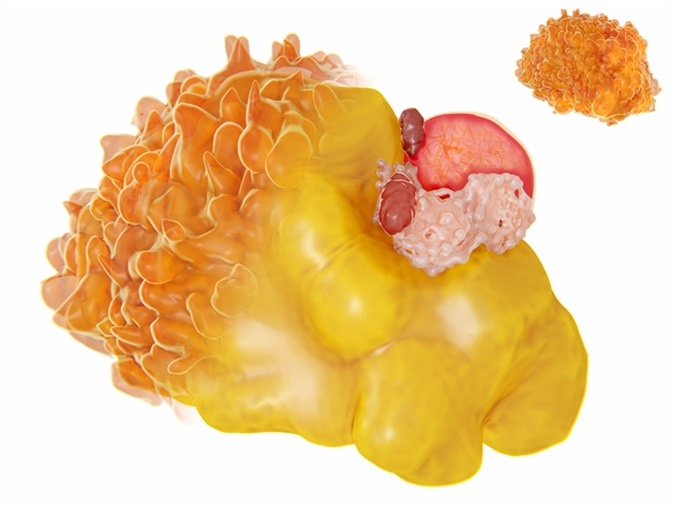The complete set of lipids in an organism or a cell along with its interactions with other molecules, such as other lipids, proteins, and metabolites constitutes the lipidome. Lipidomics is the comprehensive and quantitative study of the lipidome. It involves identification and quantitation of thousands of biological pathways involving lipids and their interactions.

Structure of a fat cell. 3D rendering. Fat cells contain a large lipid droplet (yellow), a nucleus (red) and cell organelles located in the periphery. Image Credit: Juan Gaertner / Shutterstock
Mass Spectrometry and Lipidomics
The concept of the lipidome was introduced in the scientific literature in 2001. Mass spectrometry has become the principle technique for lipidomics. Electrospray ionization (ESI) mass spectrometry and matrix-assisted laser desorption/ionization (MALDI) mass spectrometry are two methods that work well with lipids. They volatilize high mass compounds like intact lipids so that they can be further analyzed. There are three types of lipidomics studies commonly carried out using mass spectrometry.
Insights from the experts series - Novel approaches in lipidomics research
Global Lipidomic Analysis
Global lipidomic analysis involves the identification and quantification of hundreds to thousands of lipid species.
High Throughput Analysis
High throughput analysis is achieved using various shotgun-style lipidomics platforms.
Targeted Lipidomics Analysis
Targeted lipidomics analysis is the identification of one or few lipids of interest. In novel lipid discovery, liquid chromatography is coupled with mass spectrometry to find new classes of lipids and related molecular species.
MALDI-based mass spectrometry can also be coupled with thin-layer chromatography for imaging lipids from tissue slides. With ESI MS, phospholipids can be identified. Phospholipids are more sensitive to oxidation, light, and enzyme breakdown. The use of ESI to ionize phospholipids by metal ion adduction produces unique fragmentation patterns that enable analysis.
Other Methods for Lipidomics Studies
Other methods that have been used in lipidomics studies include the polymerase chain reaction (PCR), DNA microarrays, in vivo expression technology (IVET), signature-tagged mutagenesis (STM), and differential fluorescence induction (DFI).
Lipidomics and Disease
Capturing and comparing lipid profiles between two physiologically linked conditions can identify pathways of lipid metabolism that allows development of diagnostic methods.
Lipids play a role in some several chronic diseases, including diabetes and heart disease. Dyslipidemia is a major feature of those illnesses. Cholesterol and triglycerides are two types of lipids that are widely used as biomarkers for predicting disease risk. Lipidomics has the potential to provide many more lipid species that could be used as biomarkers for chronic diseases including cardiovascular disease and neurological disorders like bipolar disorder, schizophrenia, and Alzheimer’s disease.
Many diseases are by changes in lipid interactions. For example, aggregates of β-amyloid are promoted by interaction with ganglioside; molecules made of glycosphingolipid, sialic acids, and synucleins (which are associated with Parkinson’s disease) bind to fatty acids and other lipids.
Dr John Woulfe - CIHR Training Program in Neurodegenerative Lipidomics
Lipidomics Challenges
There are several challenges associated with lipidomics studies. First, the high volume of information requires large databases linked to analytical and bioinformatics platforms that can generate lipid profile data and analyzing it. Second, the diversity of lipids across different cell types and organisms make it unlikely that lipidomic data can be contained in a single database. Mechanisms are needed to interrogate different databases. Last, lipid databases currently lack the level of detail provided by the latest LC/MS-based approaches.
Further Reading